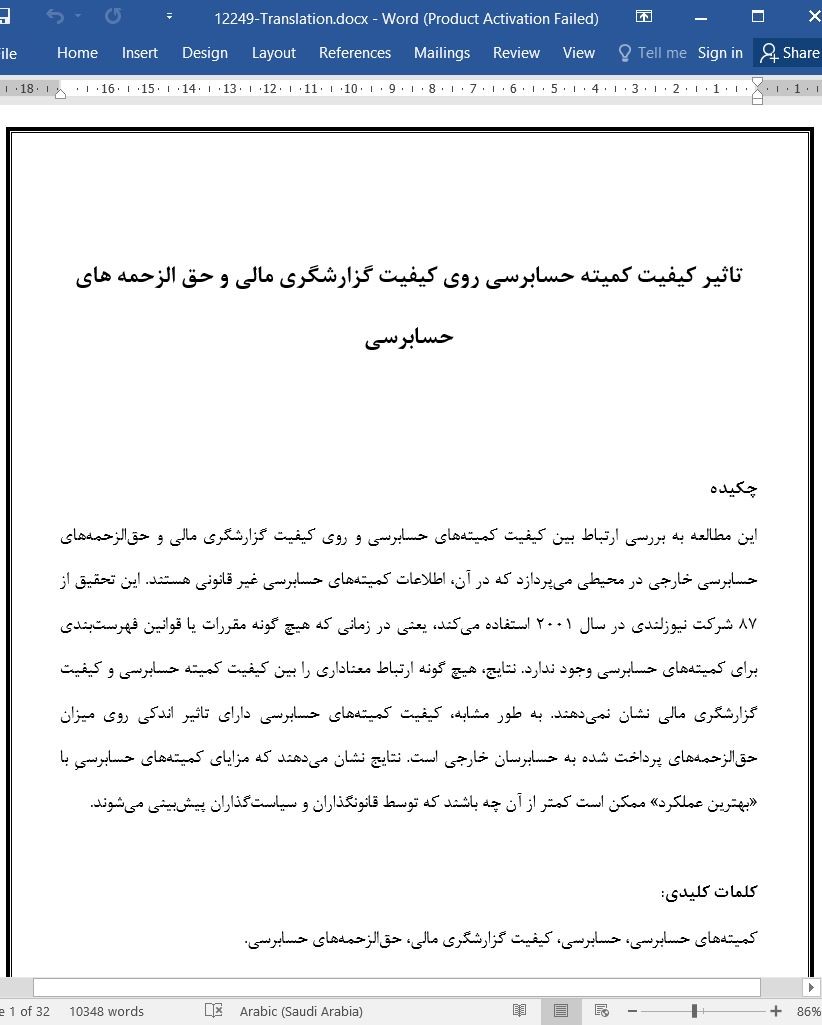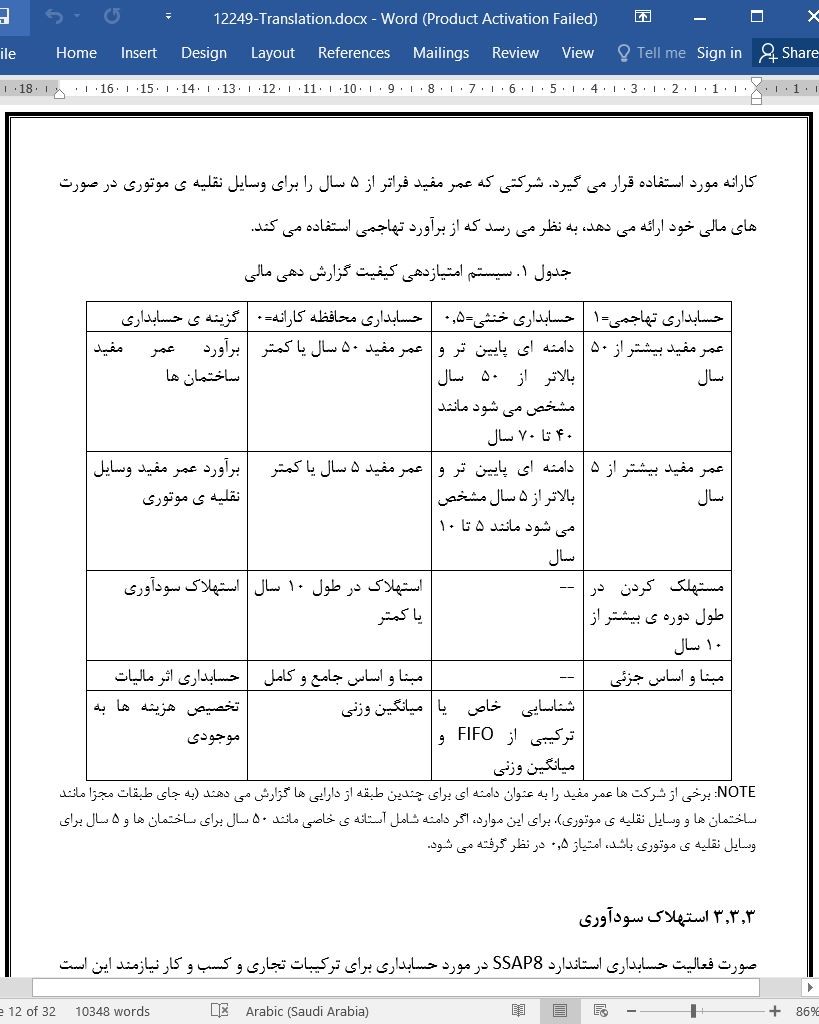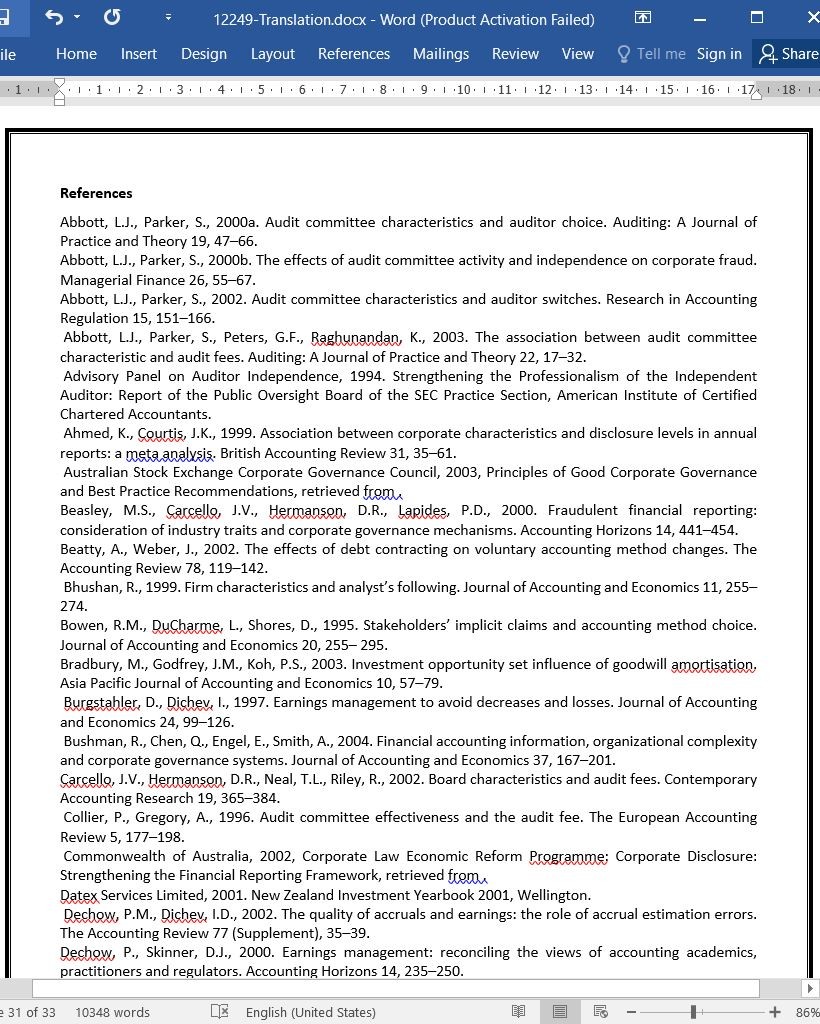
تاثیر کیفیت کمیته حسابرسی روی کیفیت گزارشگری مالی و حق الزحمه های حسابرسی
چکیده
این مطالعه به بررسی ارتباط بین کیفیت کمیتههای حسابرسی و روی کیفیت گزارشگری مالی و حقالزحمههای حسابرسی خارجی در محیطی میپردازد که در آن، اطلاعات کمیتههای حسابرسی غیر قانونی هستند. این تحقیق از 87 شرکت نیوزلندی در سال 2001 استفاده میکند، یعنی در زمانی که هیچ گونه مقررات یا قوانین فهرستبندی برای کمیتههای حسابرسی وجود ندارد. نتایج، هیچ گونه ارتباط معناداری را بین کیفیت کمیته حسابرسی و کیفیت گزارشگری مالی نشان نمیدهند. به طور مشابه، کیفیت کمیتههای حسابرسی دارای تاثیر اندکی روی میزان حقالزحمههای پرداخت شده به حسابرسان خارجی است. نتایج نشان میدهند که مزایای کمیتههای حسابرسیِ با «بهترین عملکرد» ممکن است کمتر از آن چه باشند که توسط قانونگذاران و سیاستگذاران پیشبینی میشوند.
مقدمه:
ما شرکت هایی را بررسی می کنیم که به صورت داوطلبانه کمیته های حسابرسی با کیفیتی را در محیطی مانند کشور نیوزیلند اتخاذ می کنند که قبل از سال 2003، شکل گیری کمیته های حسابرسی به طور کامل، تنظیم و کنترل نشده بود. بنابراین، در مقایسه با سایر کشورها مانند ایالات متحده امریکا که الزامات و فهرست بندی بورس اوراق بهادار نیویورک NYSE از زمان های گذشته نیازمند کمیته های حسابرسی بوده است و انگلستان که کدهای منتشر شده در سال 1992 به میزان زیادی کمیته های حسابرسی با حضور حداقل 3 عضو غیراجرایی را بیان می کردند، شرکت های نیوزیلند می توانستند در این خصوص تصمیم گیری نمایند که آیا یک کمیته ی حسابرسی باید شکل گیرد یا خیر، در صورت شکل گیری کمیته، ترکیب آن به چه صورت خواهد بود. بنابراین، در محیط قبل از سال 2003، وجود و ترکیب کمیته های حسابرسی در نیوزیلند دارای تنوع گسترده ای است و فرصت منحصر به فردی را برای بررسی مزایایی فراهم می سازد که ممکن است منتج به شرکت هایی شود که اکنون کمیته های حسابرسی را اتخاذ می کنند. از آن جایی که شکل گیری کمیته ی حسابرسی به صوت داوطلبانه و اختیاری بود، قدرت کمیته ی حسابرسی باید ارتباط نزدیکی با مزایای مربوط به کمیته ی حسابرسی داشته باشد زیرا یک شرکت انگیزه ای برای ایجاد کمیته ی حسابرسی ندارد تا زمانی که به عنوان یک گزینه ی بهینه مطرح شود. در نتیجه، مجموعه ی مطالعاتی ما با سایر مجموعه های به کار برده شده در مطالعات قبلی متفاوت است که قوانین و مقررات یا تشویق و ترغیب از طریق کدها و هنجارهای شرکتی می تواند شرکت ها را مجبور کند تا کمیته های حسابرسی را به عنوان بهترین گزینه ی دوم اتخاذ نمایند.
Abstract
This study examines the association between the quality of audit committees on financial reporting quality and external audit fees in an environment where the formation of audit committees was unregulated. The study uses a sample of 87 New Zealand firms in 2001 when no regulations or listing rules existed for audit committees. The results show no significant association between the quality of an audit committee and the quality of financial reporting. These results are robust to alternative measures of earnings quality. Similarly, the quality of audit committees has little impact on the level of fees paid to external auditors. The results suggest that the benefits of ‘best practice’ audit committees may be less than anticipated by regulators and policymakers.
1. Introduction
We examine firms that voluntarily adopt a high quality audit committee in an environment, New Zealand, where prior to 2003, the formation of audit committees was completely unregulated. Thus, compared to other countries such as the US where New York Stock Exchange (NYSE) listing requirements have long required audit committees and the UK where the high profile Cadbury Code published in 1992 strongly recommends audit committees with ‘at least three non-executive directors’, prior to 2003, New Zealand companies had considerable leeway in deciding whether an audit committee should be formed and its composition if one was formed. Thus, in the pre-2003 environment, the existence and composition of audit committees in New Zealand varied widely, providing a unique opportunity to examine the benefits that might accrue to firms that adopted what now would be considered ‘best practice’ audit committees. Since audit committee formation was voluntary, the strength of the audit committee should be closely related to the expected benefits associated with the audit committee as a firm would have no incentive to create a best practice audit committee unless it was the optimal choice. As a result, our setting differs from the settings used in most prior studies where regulations or strong encouragement through corporate codes could force firms to adopt best practice audit committees as a second-best option.
6. Conclusion
The corporate collapses in the early 2000s prompted regulators to improve the quality and oversight of financial reporting by improving the effectiveness of audit committees. For example, best practice recommendations issued by the NZSC in 2004 affirm that audit committees should be structured with all non-executive directors, a majority of them being independent, and include a director with financial expertise. However, before these recommendations were released, some New Zealand firms already had audit committees that satisfied these best practice guidelines. The purpose of this study is to examine the financial reporting quality and audit fees for firms that voluntarily formed high quality audit committees.
چکیده
1. مقدمه
2. تحقیقات تجربی قبلی
2.1. ارتباط بین کیفیت کمیته حسابرسی و کیفیت گزارشگری مالی
2.2. ارتباط بین کیفیت کمیته حسابرسی روی کیفیت گزارشگری مالی و حقالزحمههای حسابرسی
3. متغیرها، مدلها و دادهها
3.1. کیفیت کمیته حسابرسی
3.2 کیفیت گزارش دهی مالی
3.3 گزینه ها و انتخاب های حسابداری
3.3.1 براورد عمر مفید به کار رفته برای ساختمان ها
3.3.2 برآورد عمر مفید به کار رفته برای وسایل نقلیه ی موتوری
3.3.3 استهلاک سودآوری
3.3.4 حسابداری اثر مالیاتی
3.3.5 تخصیص هزینه ها به موجودی
3.4 امتیاز کیفیت گزارش دهی مالی
3.5 مدل کیفیت گزارش دهی مالی
3.5.1 فرصت های رشد MTB
3.5.2 اهرم LEV
3.5.3 پاداش مدیریت BONUS
3.5.4 عملکرد LOSS
3.5.5 افزایش سرمایه گذاری و تامین مالی بیرونی EXTFIN
3.5.6 اندازه ی شرکت SIZE
3.6 مدل هزینه های حسابرسی
3.7 نمونه و داده ها
4. نتایج برای کیفیت گزارشگری مالی
4.1. تجزیه و تحلیلهای تک متغیره
4.2. تجزیه و تحلیل چند متغیره
4.3. تجزیه و تحلیل حساسیت
4.3.1 معیارهای پیشنهادی کیفیت سود
4.3.2. همزمانی
5. نتایج برای حقالزحمههای حسابرسی
6. نتیجهگیری
منابع
Abstract
1. Introduction
2. Prior empirical literature
2.1. Relation between audit committee quality and financial reporting quality
2.2. Relation between audit committee quality on the audit function and audit fees
3. Variables, models and data
3.1. Audit committee quality
3.2. Financial reporting quality
3.3. Accounting choices
3.3.1. The estimated useful life applied to buildings
3.3.2. The estimated useful life applied to motor vehicles
3.3.3. Goodwill amortization
3.3.4. Tax effect accounting
3.3.5. Assigning costs to inventory
3.4. Financial reporting quality score
3.5. The financial reporting quality model
3.5.1. Growth opportunities (MTB)
3.5.2. Leverage (LEV)
3.5.3. Management bonuses (BONUS)
3.5.4. Performance (LOSS)
3.5.5. Raising external finance (EXTFIN)
3.5.6. Firm size (SIZE)
3.6. The audit fee model
3.7. Sample and data
4. Results for financial reporting quality
4.1. Univariate analyses
4.2. Multivariate analysis
4.3. Sensitivity analysis
4.3.1. Alternative earnings quality measures
4.3.2. Simultaneity
5. Results for audit fees
6. Conclusion
References
- اصل مقاله انگلیسی با فرمت ورد (word) با قابلیت ویرایش
- ترجمه فارسی مقاله با فرمت ورد (word) با قابلیت ویرایش، بدون آرم سایت ای ترجمه
- ترجمه فارسی مقاله با فرمت pdf، بدون آرم سایت ای ترجمه



